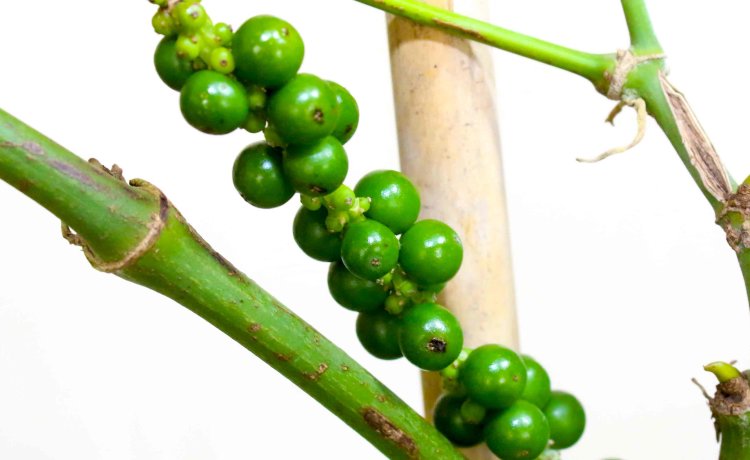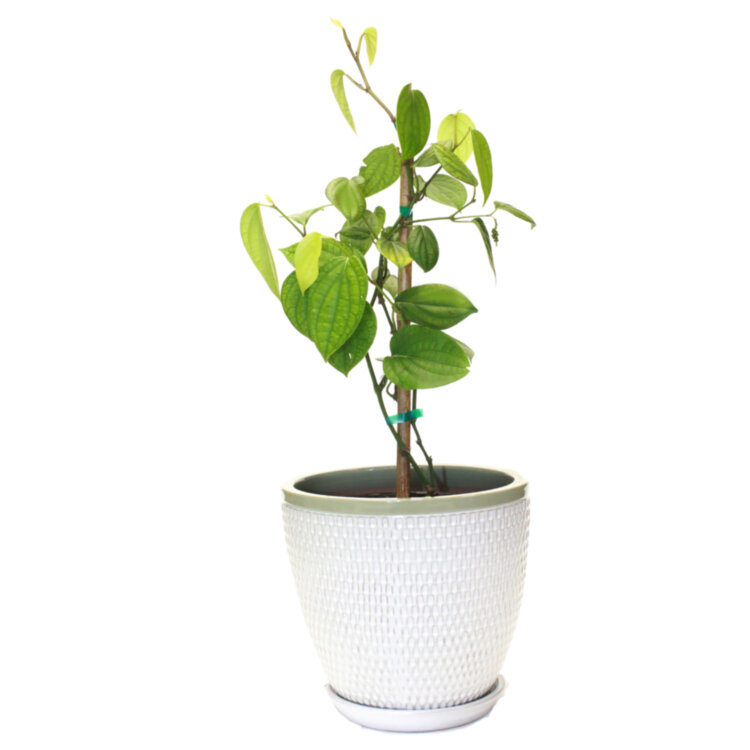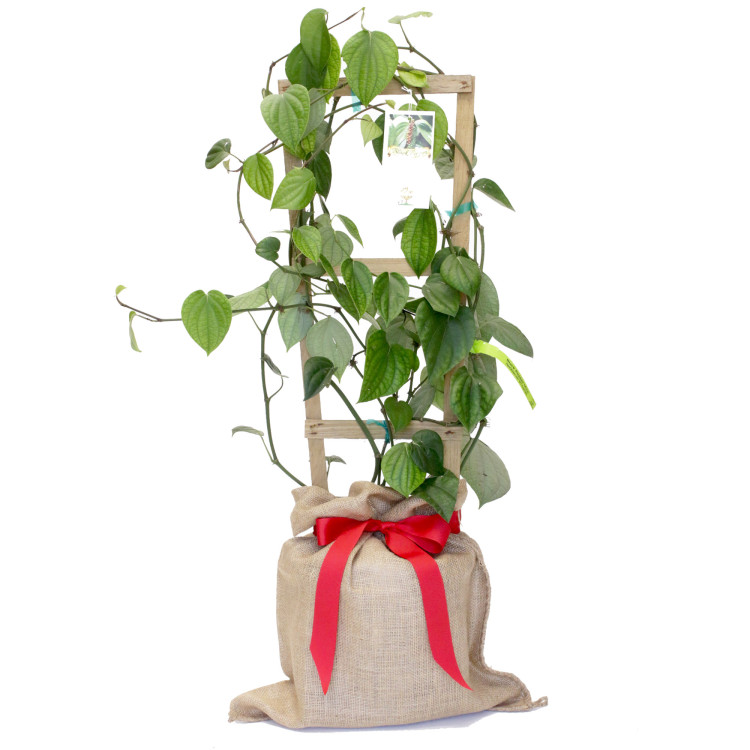- Overview
Common name: Black Pepper Botanical name: Piper nigrum Family: Piperaceae Avg Height X Width: 12' x 12' Origin: India or Indo-Malayan region Growth Habit: Weak climbing or trailing vine up to 30'. Season: year round, but heaviest in warm months Damage temp: 28-30 F Black Pepper vine in a 3 gallon container. Black pepper is a common spice and a staple on table around the world. They can be grown in a pot or raised bed in acid soil such as Canadian Peat. The plants prefer some shade. Black pepper is the dried unripe fruit of small one-seeded berrylike drupes about 50 to a catkin. They are usually picked when the first 'berry' begins to turn red. Before drying they may be used fresh green. When dried they become the black wrinkled peppercorns. They will flower in the spring and fruit ripen in summer. Excellent for the collector or the tropical spice novice as this is one of the easiest spices to grow. Makes a great container plant.
Description
Soil
Production
History
Medicinal Uses
Description
Black pepper (Piper nigrum) is a flowering vine in the family Piperaceae, cultivated for its fruit, which is usually dried and used as a spice and seasoning. In dried form, the fruit is often referred to as peppercorns. Peppercorns, and the powdered pepper derived from grinding them, may be described as black pepper, white pepper, red/pink pepper, and green pepper, though the terms pink peppercorns, red pepper, and green pepper are also used to describe the fruits of other, unrelated plants.
Black pepper is native to South India and is extensively cultivated there and elsewhere in tropical regions. The fruit, known as a peppercorn when dried, is a small drupe five millimetres in diameter, dark red when fully mature, containing a single seed.Dried ground pepper is one of the most common spices in European cuisine and its descendants, having been known and prized since antiquity for both its flavour and its use as a medicine. The spiciness of black pepper is due to the chemical piperine. Ground black peppercorn, usually referred to simply as "pepper", may be found on nearly every dinner table in some parts of the world, often alongside table salt.
The word "pepper" is ultimately derived from the Sanskrit pippali, the word for long pepper via the Latin piper which was used by the Romans to refer both to pepper and long pepper, as the Romans erroneously believed that both of these spices were derived from the same plant. The English word for pepper is derived from the Old English pipor. The Latin word is also the source of German Pfeffer, French poivre, Dutch peper, and other similar forms. In the 16th century, pepper started referring to the unrelated New World chile peppers as well. "Pepper" was used in a figurative sense to mean "spirit" or "energy" at least as far back as the 1840s; in the early 20th century, this was shortened to pep.
Soil
The pepper plant is a perennial woody vine growing to four metres in height on supporting trees, poles, or trellises. It is a spreading vine, rooting readily where trailing stems touch the ground. The leaves are alternate, entire, five to ten centimetres long and three to six centimetres broad. The flowers are small, produced on pendulous spikes four to eight centimetres long at the leaf nodes, the spikes lengthening to seven to 15 centimeters as the fruit matures.
Black pepper is grown in soil that is neither too dry nor susceptible to flooding, moist, well-drained and rich in organic matter. The plants are propagated by cuttings about 40 to 50 centimetres long, tied up to neighbouring trees or climbing frames at distances of about two metres apart; trees with rough bark are favoured over those with smooth bark, as the pepper plants climb rough bark more readily. Competing plants are cleared away, leaving only sufficient trees to provide shade and permit free ventilation. The roots are covered in leaf mulch and manure, and the shoots are trimmed twice a year. On dry soils the young plants require watering every other day during the dry season for the first three years. The plants bear fruit from the fourth or fifth year, and typically continue to bear fruit for seven years. The cuttings are usually cultivars, selected both for yield and quality of fruit. A single stem will bear 20 to 30 fruiting spikes. The harvest begins as soon as one or two berries at the base of the spikes begin to turn red, and before the fruit is mature, but when full grown and still hard; if allowed to ripen, the berries lose pungency, and ultimately fall off and are lost. The spikes are collected and spread out to dry in the sun, then the peppercorns are stripped off the spikes.
Production
Black pepper is produced from the still-green unripe berries of the pepper plant. The berries are cooked briefly in hot water, both to clean them and to prepare them for drying. The heat ruptures cell walls in the fruit, speeding the work of browning enzymes during drying. The berries are dried in the sun or by machine for several days, during which the fruit around the seed shrinks and darkens into a thin, wrinkled black layer, the result of a fungal reaction. Once dried, the fruits are called black peppercorns.
History
Pepper has been used as a spice in India since prehistoric times. Pepper is native to India and has been known to Indian cooking since at least 2000 BC. J. Innes Miller notes that while pepper was grown in southern Thailand and in Malaysia, its most important source was India, particularly the Malabar Coast, in what is now the state of Kerala. Peppercorns were a much prized trade good, often referred to as "black gold" and used as a form of commodity money. The term "peppercorn rent" still exists today.
The ancient history of black pepper is often interlinked with (and confused with) that of long pepper, the dried fruit of closely related Piper longum. The Romans knew of both and often referred to either as just "piper". In fact, it was not until the discovery of the New World and of chile peppers that the popularity of long pepper entirely declined. Chile peppers, some of which when dried are similar in shape and taste to long pepper, were easier to grow in a variety of locations more convenient to Europe.
Until well after the Middle Ages, virtually all of the black pepper found in Europe, the Middle East, and North Africa travelled there from India's Malabar region. By the 16th century, pepper was also being grown in Java, Sunda, Sumatra, Madagascar, Malaysia, and elsewhere in Southeast Asia, but these areas traded mainly with China, or used the pepper locally. Ports in the Malabar area also served as a stop-off point for much of the trade in other spices from farther east in the Indian Ocean.
Black pepper, along with other spices from India and lands farther east, changed the course of world history. It was in some part the preciousness of these spices that led to the European efforts to find a sea route to India and consequently to the European colonial occupation of that country, as well as the European discovery and colonization of the Americas.
Black peppercorns were found stuffed in the nostrils of Ramesses II, placed there as part of the mummification rituals shortly after his death in 1213 BC. Little else is known about the use of pepper in ancient Egypt, nor how it reached the Nile from India.
Pepper (both long and black) was known in Greece at least as early as the 4th century BC, though it was probably an uncommon and expensive item that only the very rich could afford. Trade routes of the time were by land, or in ships which hugged the coastlines of the Arabian Sea. Long pepper, growing in the north-western part of India, was more accessible than the black pepper from further south; this trade advantage, plus long pepper's greater spiciness, probably made black pepper less popular at the time.
By the time of the early Roman Empire, especially after Rome's conquest of Egypt in 30 BC, open-ocean crossing of the Arabian Sea directly to southern India's Malabar Coast was near routine. According to the Roman geographer Strabo, the early Empire sent a fleet of around 120 ships on an annual one-year trip to India and back. The fleet timed its travel across the Arabian Sea to take advantage of the predictable monsoon winds. Returning from India, the ships travelled up the Red Sea, from where the cargo was carried overland or via the Nile Canal to the Nile River, barged to Alexandria, and shipped from there to Italy and Rome. The rough geographical outlines of this same trade route would dominate the pepper trade into Europe for a millennium and a half to come.
With ships sailing directly to the Malabar coast, black pepper was now travelling a shorter trade route than long pepper, and the prices reflected it. Pliny the Elder's Natural History tells us the prices in Rome around 77 CE: "Long pepper ... is fifteen denarii per pound, while that of white pepper is seven, and of black, four." Pliny also complains "there is no year in which India does not drain the Roman Empire of fifty million sesterces," and further moralises on pepper:
It is quite surprising that the use of pepper has come so much into fashion, seeing that in other substances which we use, it is sometimes their sweetness, and sometimes their appearance that has attracted our notice; whereas, pepper has nothing in it that can plead as a recommendation to either fruit or berry, its only desirable quality being a certain pungency; and yet it is for this that we import it all the way from India! Who was the first to make trial of it as an article of food? and who, I wonder, was the man that was not content to prepare himself by hunger only for the satisfying of a greedy appetite? (N.H. 12.14)
Black pepper was a well-known and widespread, if expensive, seasoning in the Roman Empire. Apicius' De re coquinaria, a 3rd-century cookbook probably based at least partly on one from the 1st century CE, includes pepper in a majority of its recipes. Edward Gibbon wrote, in The History of the Decline and Fall of the Roman Empire, that pepper was "a favourite ingredient of the most expensive Roman cookery".
Postclassical Europe
Postclassical Europe Pepper was so valuable that it was often used as collateral or even currency. The taste for pepper (or the appreciation of its monetary value) was passed on to those who would see Rome fall. It is said that Alaric the Visigoth and Attila the Hun each demanded from Rome a ransom of more than a ton of pepper when they besieged the city in 5th century. After the fall of Rome, others took over the middle legs of the spice trade, first the Persians and then the Arabs; Innes Miller cites the account of Cosmas Indicopleustes, who travelled east to India, as proof that "pepper was still being exported from India in the sixth century". By the end of the Dark Ages, the central portions of the spice trade were firmly under Islamic control. Once into the Mediterranean, the trade was largely monopolised by Italian powers, especially Venice and Genoa. The rise of these city-states was funded in large part by the spice trade.
A riddle authored by Saint Aldhelm, a 7th-century Bishop of Sherborne, sheds some light on black pepper's role in England at that time:
I am black on the outside, clad in a wrinkled cover,
Yet within I bear a burning marrow.
I season delicacies, the banquets of kings, and the luxuries of the table,
Both the sauces and the tenderized meats of the kitchen.
But you will find in me no quality of any worth,
Unless your bowels have been rattled by my gleaming marrow.
It is commonly believed that during the Middle Ages, pepper was used to conceal the taste of partially rotten meat. There is no evidence to support this claim, and historians view it as highly unlikely: in the Middle Ages, pepper was a luxury item, affordable only to the wealthy, who certainly had unspoiled meat available as well. In addition, people of the time certainly knew that eating spoiled food would make them sick. Similarly, the belief that pepper was widely used as a preservative is questionable: it is true that piperine, the compound that gives pepper its spiciness, has some antimicrobial properties, but at the concentrations present when pepper is used as a spice, the effect is small. Salt is a much more effective preservative, and salt-cured meats were common fare, especially in winter. However, pepper and other spices probably did play a role in improving the taste of long-preserved meats.
Its exorbitant price during the Middle Ages — and the monopoly on the trade held by Italy — was one of the inducements which led the Portuguese to seek a sea route to India. In 1498, Vasco da Gama became the first European to reach India by sea; asked by Arabs in Calicut (who spoke Spanish and Italian) why they had come, his representative replied, "we seek Christians and spices." Though this first trip to India by way of the southern tip of Africa was only a modest success, the Portuguese quickly returned in greater numbers and used their superior naval firepower to eventually gain complete control of trade on the Arabian sea. It was given additional legitimacy (at least from a European perspective) by the 1494 Treaty of Tordesillas, which granted Portugal exclusive rights to the half of the world where black pepper originated.
The Portuguese proved unable to maintain their stranglehold on the spice trade for long. The old Arab and Venetian trade networks successfully smuggled enormous quantities of spices through the patchy Portuguese blockade, and pepper once again flowed through Alexandria and Italy, as well as around Africa. In the 17th century, the Portuguese lost almost all of their valuable Indian Ocean possessions to the Dutch and the English. The pepper ports of Malabar fell to the Dutch in the period 1661–1663.
According to the blog Slashfood, seventeenth-century French cuisine considered pepper the only spice (as distinct from herbs such as fines herbes) which did not overpower the true taste of food; this led to its pairing with table salt as table condiments, salt and pepper.
As pepper supplies into Europe increased, the price of pepper declined (though the total value of the import trade generally did not). Pepper, which in the early Middle Ages had been an item exclusively for the rich, started to become more of an everyday seasoning among those of more average means. Today, pepper accounts for one-fifth of the world's spice trade.
Medicinal Uses
Like many eastern spices, pepper was historically both a seasoning and a medicine. Long pepper, being stronger, was often the preferred medication, but both were used.
Black peppercorns figure in remedies in Ayurveda, Siddha and Unani medicine in India. The 5th century Syriac Book of Medicines prescribes pepper (or perhaps long pepper) for such illnesses as constipation, diarrhea, earache, gangrene, heart disease, hernia, hoarseness, indigestion, insect bites, insomnia, joint pain, liver problems, lung disease, oral abscesses, sunburn, tooth decay, and toothaches. Various sources from the 5th century onward also recommend pepper to treat eye problems, often by applying salves or poultices made with pepper directly to the eye. There is no current medical evidence that any of these treatments has any benefit; pepper applied directly to the eye would be quite uncomfortable and possibly damaging.
Pepper has long been believed to cause sneezing; this is still believed true today. Some sources say that piperine, a substance present in black pepper, irritates the nostrils, causing the sneezing; some say that it is just the effect of the fine dust in ground pepper, and some say that pepper is not in fact a very effective sneeze-producer at all. Few, if any, controlled studies have been carried out to answer the question.
As a medicine, Pepper appears in the Buddhist monastic code, chapter five, as one of the few medicines allowed to be carried by a monk.
Pepper is eliminated from the diet of patients having abdominal surgery and ulcers because of its irritating effect upon the intestines, being replaced by what is referred to as a bland diet.
Pepper contains small amounts of safrole, a mildly carcinogenic compound.
It has been shown that piperine can dramatically increase absorption of selenium, vitamin B and beta-carotene as well as other nutrients - Features
weight: 9.99 lbs : - ReviewsThere is no reviews yet...Be the first!
Be the first to write a review of this product!











